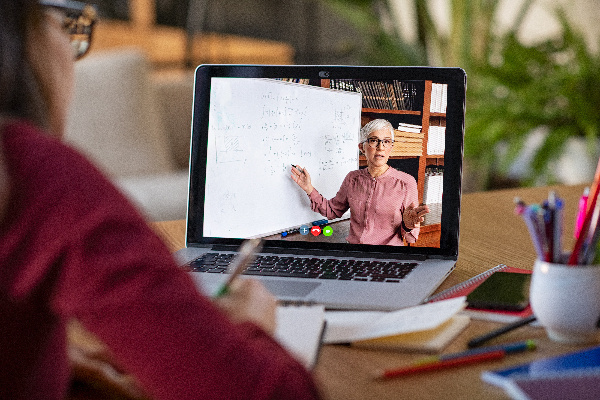Published on
Blending Online Learning and Human Connections in Higher Ed

While online learning presents major advantages to students seeking flexibility and accessibility in their education, it is only successful when grounded in interpersonal connections.
When the COVID-19 pandemic forced nearly every college student to learn remotely, observers wondered whether the sudden surge in online learning would outlast it. At many community colleges, the answer seems to be a resounding yes. Years later, the number of community college students studying online remains considerably higher than before 2020. One recent analysis found that nearly 40 two-year institutions now have at least 10,000 students enrolled fully online.
While this shift may have felt forced at the onset, what it precipitated was an incredible expansion in access to higher education and a transformation in the way institutions support their students. The flexibility of online programs allows busy learners to pursue their education whenever and wherever they can, providing access to students who have been historically underserved. Plus, with the move to virtual learning, institutions have gained the ability to better understand student behaviors and motivations. Meanwhile, data from online programs gives colleges a great deal of insight into student learning activity and performance, enabling personalized holistic support to keep learners on the path to success. As more and more digital natives enter higher education, online learning has evolved from a novelty to a necessity, opening more doors for students nationally.
While excitement about the possibilities of virtual education modalities is growing, it’s crucial to remember that online learning is not a magic-wand solution for offering quality higher education at scale. It requires thoughtful planning to ensure its potential drawbacks do not undermine it benefits, as we saw in the early days of the pandemic. When implemented without intention or a deep understanding of how to best leverage these tools, the advantages of learning online can just as easily become its limitations.
Online education must also be used to address the high cost of higher education, which remains a considerable hurdle to boosting college enrollment and completion. It’s appalling that we have normalized saddling young people with tens of thousands of dollars of debt before they even enter the workforce. A college education should serve as an affordable, effective springboard to a successful career. Perhaps more than other institutions, schools offering two-year degree programs are keenly aware of this challenge and have been working tirelessly to address it. These institutions are the gateway to higher education for millions of students each year. This access mission has also led two-year schools to embrace online learning’s affordability, accessibility, and flexibility, positioning them as leaders in the online learning revolution.
And while these schools serve a vast and diverse group of students, just 36.4% of students at two-year colleges graduate within three years. These students are often older and juggling coursework while working full time, starting a business or raising a family. A significant number of them are returning learners who have been unsuccessful in their previous attempts at obtaining a degree and are struggling to shift back into the student mindset without support. At Campus, we have learned from our board of former college presidents—which includes leaders like Dr. John Wilson, former president of Morehouse College, and Dr. Eduardo Padron, President Emeritus of Miami Dade College—that what might feel like a minor hurdle to some, such as a temporary internet outage or unexpected expense, can completely derail another student’s educational journey.
Programs like the City University of New York’s Accelerated Study in Associate Programs (ASAP) have demonstrated that, with comprehensive support, all students can excel. However, designing resources that meet such a diverse range of student needs is difficult enough in face-to-face settings, let alone in an online environment, where there are greater chances for learners to become disconnected and disengaged.
The asynchronous nature of many online programs means that students cannot speak up during class or grab their instructor for a quick question at the end of a lecture. It means faculty and staff cannot easily identify when a student is experiencing a challenge that needs immediate attention or intervention. While asynchronous formats can be effective for self-paced learners, most students benefit from real-time engagement with instructors and their peers. This type of relationship-centered learning is not possible when online courses are primarily built around prerecorded lectures.
The flexibility of online learning and the insights institutions can glean about student experiences through online education platforms both mean very little if such programs are not paired with the human touch that is so crucial to student success. We must give our online students the opportunity to build meaningful relationships, broaden their networks and expand their understanding of others. While digital learning is being embraced for its ability to meet learners where they are, online programs must be designed to mirror the immediacy—and impact—of human-to-human classroom interactions.
As colleges continue to innovate and evolve in the post-COVID era, it is critical they do not lose sight of the human element that underpins student success. The strongest path forward for our next generation of college students will combine online learning’s power to traverse space and time with the human connections that have always fostered deeper learning and personal growth.



